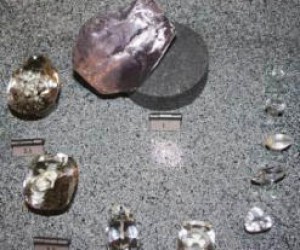Last month a rare 25.5-carat blue diamond was found at the Cullinan Mine, the third biggest diamond producer in South Africa. Blue diamonds are among the rarest and most highly coveted of all diamonds, and the Cullinan mine is the most important source of blues in the world, according to Petra Diamonds, the company that owns the mine.
"They are so rare that there aren't official statistics on their discovery rate," says Cathy Malins, Petra's corporate communications manager. In the five years that Petra has operated the mine, over 15 million tonnes of rock have been brought to the surface, producing about five million carats – but only three world-class blue diamonds, she adds.
A carat refers to the weight of a diamond. One carat equals 0.2 grams. The diamonds are recovered from one of the biggest kimberlite pipes in the world. Kimberlite is named after the South African diamond mining town of Kimberley, where the gems were first discovered in the country. It refers to a type of potassic volcanic rock known to contain diamonds.
Cullinan is some 40 kilometres northeast of Pretoria in Gauteng. The mine goes to a depth of 732 metres, where this blue diamond was found. "Once the ore is transported to surface, it goes through the processing plant and the blue diamond was recovered during the normal process of concentrating underground material, with final recovery by method of x-ray," says Malins.
In the past five years, several blue diamonds have been recovered at Petra, including a 26.6-carat rough stone that was cut into a flawless and vivid blue seven-carat stone that sold for US$9.49 million – or US$1.35m per carat – on auction in May 2009. At the time, it was the highest price per carat for any gemstone sold on auction, and the highest price for a blue diamond sold on auction. It was named the 'Star of Josephine' by its new owner, a Hong Kong property tycoon.
Malins indicates that it is not clear exactly at present what will be done with the latest discovery. "The blue is currently being evaluated in order to decide the best route to market," she says.
In all, the Cullinan Mine has yielded 11 rare blues, which were displayed in 2000 at London's Millennium Dome alongside the Millennium Star. Famous larger blues recovered at the mine include the 27-carat vivid blue Heart of Eternity, and an unnamed 39.2-carat rough blue that was recovered and sold in 2008.
Petra Diamonds indicates that demand for the gems continues to rise, particularly in developing countries such as China and India. "Demand growth for diamonds in emerging markets is expected to continue as global wealth and consumer spending increase," says the mining house.
At present, there are 30 significant diamond mines operating in the world today. "To date, the most important discoveries (other than Argyle in Australia) have clustered into three regions of the world: southern Africa, Siberia and western Canada."
The Cullinan Diamond
The world's most famous diamond was found in Cullinan around 1905 by Frederick Wells. Thomas Cullinan had bought the farm Elandsfontein in 1903 when he heard that an English prospector, Perceval Tracey, had found a three-carat diamond on the neighbouring farm. The diamond was found 9m down, protruding from the pit wall.
Known as the 'Cullinan Diamond', it was 3 106 carats and measured 10.5 centimetres across, and was as large as a man's fist. The huge diamond was cut into nine diamonds of varying sizes, the largest, named 'Cullinan 1' or 'The Great Star of Africa', weighed 530.2 carats. It is the second largest polished diamond in the world. It, together with the lesser Star of Africa or Cullinan II, forms part of the British Imperial State Crown, and are on display in the Tower of London. They were given to King Edward VII of England on his 66th birthday.
The largest polished diamond in the world, the 545-carat Golden Jubilee, also comes from Cullinan. Thomas Cullinan, who was later knighted, was a building contractor. His house, on the ridge in Parktown, Johannesburg, still exists. He remained involved in the mine until 1923, when he resigned as chairperson. He died in 1936.
Other large diamonds
Other large diamonds recovered at Cullinan include the Premier Rose (353 carats), the Niarchos (426 carats), the De Beers Centenary (599 carats), the Golden Jubilee (755 carats) and the famous Taylor-Burton diamond (69 carats). More recently, the Cullinan Heritage, with 507 carats, was recovered and sold for US$35.3m in 2010 – the highest price ever obtained for a rough diamond.
Over the years, the mine has produced more than 750 stones weighing more than 100 carats, 130 stones weighing more than 200 carats, and around a quarter of all diamonds weighing more than 400 carats. Prospects for its future are good: it has been estimated that the lifespan of the mine could still be more than 50 years.
Petra acquired the Cullinan Mine in 2008, and has interests in eight other mines, seven of which are in South Africa; one is in Tanzania. It also has an exploration programme in Botswana.
When the mine was first established, about 26 000 workers were employed in the operation. Nowadays, only 1 200 people work the mine, going down 760m by means of 560 kilometres of tunnels. The early excavations have left a large hole, which is three times bigger than the more famous Kimberley hole in the Northern Cape. The vast hole measures a kilometre across and half-a-kilometre wide, and leaves a gap going down into the earth of 700m. It is continually widening, as 80 000 tonnes of rock fall into it every year.






